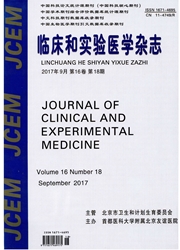

 中文摘要:
中文摘要:
目的:观察颈内动脉闭塞( ICAO)患者临床特点,通过ESSEN评分分组后评价ICAO患者的临床生化指标、以及合并其他脑血管病变情况,为早期预防、协助诊断和治疗提供帮助。方法回顾性分析2005~2012年经头颈部CTA诊断的100例ICAO住院患者,收集入组者信息,完善常规化验,明确CTA显示的ICAO部位、对侧颈内动脉有无病变、有无合并椎基底动脉病变、以及有无合并颅内其他大动脉病变等。按ESSEN评分将入组患者分为Essen评分〈3分和Essen≥3分两组,统计两组间临床生化指标、合并椎基底和/或颅内其他大动脉病变情况有无差异。结果 ESSEN评分≥3分ICAO患者其血浆同型半胱氨酸水平显著高于ESSEN评分〈3分组( P 〈0.05)。ESSEN评分≥3分的ICAO患者更容易合并椎基底动脉病变(61.67% vs.40.00%,P 〈0.05);ESSEN评分≥3分的ICAO患者合并颅内大动脉病变的数量多于ESSEN评分〈3分组( P 〈0.05);ESSEN评分≥3分的ICAO患者容易合并多支(2支或2支以上)颅内大动脉病变(67.80% vs.39.47%,P 〈0.01)。结论 ESSEN评分≥3分的患者更易合并高同型半胱氨酸血症,且其更多合并椎基底动脉病变和多支(2支或2支以上)颅内大动脉病变。
 英文摘要:
英文摘要:
Objective Using ESSEN score and stratifying to assess the clinical characteristics of patients ICAO. This method may provide evidence for the prediction of risk for recurrent cerebral stroke with ESSEN score and findings from angiography in case of CT. Methods A total of 100 ICAO patients who received CTA of the head and neck were included into this study and reviewed. On the basis of ESSEN score,patients were divided into 2 groups:ESSEN ≥3 patients and ESSEN 〈3 patients. The clinical biochemical findings and concomitant lesions of verte-brobasilar artery and/or other intracranial major arteries were compared between two groups. Results The plasma homocysteine level in ESSEN≥3 patients was significantly higher than that in ESSEN 〈3 patients( P 〈0. 05). ESSEN≥3 patients were more likely to develop concomitant le-sions of the vertebrobasilar artery(61. 67% vs. 40. 00%,P 〈0. 05). The number of lesions of intracranial major arteries in ESSEN≥3 patients was larger than that in 〈3 points group( P 〈0. 05). The number of affected intracranial major arteries(2 or more arteries)in ESSEN≥3 pa-tients was larger than that in ESSEN〈3 patients(67. 80% vs. 39. 47%,P 〈0. 01). Conclusion Patients with ESSEN≥3 were more likely to develop hyperhomocysteinemia and have concomitant lesions of vertebrobasilar artery and lesions of 2 or more intracranial major arteries.
 同期刊论文项目
同期刊论文项目
 同项目期刊论文
同项目期刊论文
 期刊信息
期刊信息
